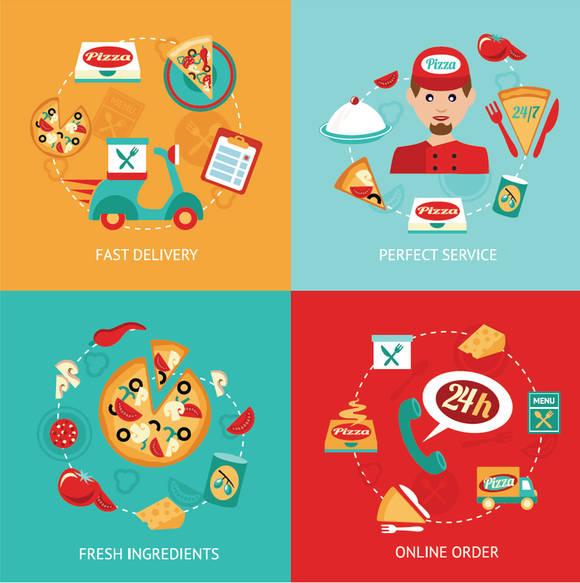[Joel의 Global Dining Market] 식품 기술이 식품 서비스 자체보다 더 강하다! - Food Tech Is More Powerful Than Foodservice Itself!
2015.12.14 10:17:14

Food Tech Is More Powerful Than Foodservice Itself!
I recently moderated a panel discussion about the big trends happening in the foodservice industry in Southeast Asia. The attendees were mostly investment professionals from Private Equity groups. The surprising part of the panel discussion was that there was little discussion about the “food” itself and more discussion about how to offset rental and labor cost inflation while meeting the consumers increasing demands for convenience. It turns out that investors are valuing the tech companies that can provide these solutions more highly than the actual foodservice operators themselves.
What Is The Problem?
Foodservice operators are facing essentially three big challenges to their business models in Southeast Asia and these issues will also be familiar to Korean readers of this magazine. First, the industry suffers from an acute shortage of manpower in most large cities and wage rates continue to rise. Many young workers simply do not want to work in the hospitality industry and their parents are pressuring them to train for more stable jobs in the government or industry. Second, tenancy costs continue to escalate despite a slowing economy. Malls in Bangkok for example, raise their rates every year in no relationship to the tenant’s performance. Costs in Jakarta malls are higher than most places in the USA, which has more than 10 times the average level of consumption expenditure per capita. Finally, consumers are becoming more demanding about everything especially convenience. They want good tasting food brought to them fast at a location they prefer.
What Are The Solutions?
The panel discussed solutions to overcome these challenges and it became clear that technology is one big answer.
Consumers are relying more on their smartphone apps to search for food alternatives, ratings of food services, and ordering. This is clearly a mixed blessing for a restaurateur for while he may like the extra volume from partnering with a delivery company, he runs the risk of annoying customers if the delivery is too slow and the food gets cold or damaged.
Delivery aggregators are emerging that represent multiple restaurant concepts and they end up having more power than the restaurants themselves. Looking at the recent valuation ($15 Billion) for companies in China like Dianping & Meituan is a good indication of the current phenomenon. These aggregators are now building their own kitchens and inviting chefs to supervise meal preparation and many are partnering with local amateur chefs in each community to offer a freshly cooked meal, which the customer can pick up on their way home from work. Tech entrepreneurs who knew nothing about the restaurant business started the great majority of these new companies. Take a look at Sprig or Josephine in San Francisco and you quickly get the idea!
In Indonesia, a package delivery company, GoJek, recently branched out into food delivery and now account for about 70% of all these transactions in Jakarta. In Shanghai, consumers on their smartphones place more than 50% of Dominos delivery orders. In New Delhi, the hottest trend is now ordering your groceries on line and having the maid accept delivery while you are at work. Time starved consumers are looking for convenience everywhere in Asia today!
There are also solutions to make life better for the restaurateur. In Japan, two amazing companies are pioneering B2B solutions for the individual proprietor. Infomat Corporation now accounts for 10% of all foodservice transactions through their B2B platforms and have over 38,000 companies participating. They are now branching out overseas and recently established a subsidiary in Hong Kong. Hachimenroppi now supplies more than 1000 independent restaurants with fresh fish every day. Stores can now bypass the Tsukiji market and buy directly from fisherman on their tablets with Hachimenroppi providing the support platforms. Which do you think investors value more highly – the platform builder, the fisherman or the restaurants? Tech wins every time.
Finally, restaurants are doing more and more outsourcing of food preparation to central kitchens to enable them to cut labor and shrink the back of the house. These commissaries are highly efficient, fully automated and very price competitive. They are more like factories than kitchens relying on technology to produce food cheaply.
My advice therefore is to get started working on an app and platform that can transform the foodservice industry by breaking up an existing model. If successful, your app will be worth much more than the actual preparers of the food. A sad commentary on current times but true!

식품 기술이 식품 서비스 자체보다 더 강하다!
최근 나는 동남아시아 요식업계에서 벌어지고 있는 주요 트렌드 대한 주제를 토론하는 자리를 마련했다. 참석자들의 대다수는 사모펀드 그룹 소속의 투자전문가들이었다. 놀랍게도 토론의 쟁점은 음식 그 자체가 아니었다. 토론자들은 증가하는 편의에 대한 소비자의 요구를 충족시키면서, 어떻게 하면 임대료와 인건비의 상승을 상쇄할 수 있는지에 이야기하고 싶어했다. 투자자들은 실상 이러한 문제들에 대한 해법을 제공하는 기술회사를 요식업체 자체 보다 높게 평가한다는 결론이 나왔다.
무엇이 문제인가?
동남아시아 국가의 요식업체들은 기본적으로 세 가지 큰 도전과제에 당면해 있는데 이 화두들은 본 잡지의 한국 독자들에게도 익숙한 문제라고 할 수 있다.
첫째로 요식업계는 대부분의 대도시에서 극심한 인력난을 겪고 있으며 인건비는 지속적으로 상승하고 있다. 많은 젊은이들은 요식업계에 종사하는 것을 원치 않으며, 그들의 부모들은 자녀가 좀 더 안정적인 정부 관련 직업이나 다른 산업계에서 일을 구할 수 있는 교육을 받도록 압력을 행사한다.
두 번째로 경기 침체에도 불구하고 임대비용은 계속해서 증가하고 있다는 것이다. 방콕의 쇼핑몰들을 예로 들자면 입주업체들의 영업실적과는 상관없이 매해 임대료를 올린다. 자카르타에 소재한 쇼핑몰들의 경우 대부분의 미국 도시들보다도 임대료가 높아 이는 1인당 평균 소비수준의 10배 이상에 해당한다.
마지막으로 소비자들은 모든 서비스 특히 편리성에 대해 점점 더 강도 높게 요구하고 있다.
해결책은 무엇인가?
토론 결과 이러한 도전 과제들을 극복하기 위한 해법 중 비중이 있는 하나는 기술력 보강이라는 것이 명료해졌다.
소비자들은 대안 음식을 찾거나 서비스 순위 검색, 음식 주문 등에 있어 점점 더 스마트폰에 의지하고 있다. 이는 레스토랑 운영자에게 단순하지만은 않은 축복이라 할 수 있다. 배달업체와 손을 잡고 매출의 양적 측면을 늘릴 수 있는 반면 배달시간이 너무 오래 걸린다던지 배달음식이 식거나 파손을 입는다던지 함으로써 소비자에게 불편을 끼치는 모험을 감수해야 하기 때문이다.
배달 사이트들은 다수의 레스토랑 콘셉트를 대표함으로써 결국에는 레스토랑 자체보다도 강한 힘을 갖게 된다. 중국의 쟝핑 앤 메이투안 사의 최근 가치(150억 달러)를 보면 근래의 이러한 현상을 이해하는 데 좋은 예가 될 수 있을 것이다.
이제 이런 사이트 사들은 자체 주방을 갖추고 요리사들을 초빙해 음식의 준비과정을 관리감독하고 있으며 각 지역의 아마추어 요리사들과 협력관계를 맺고 신선하게 조리된 음식을 준비해 소비자들이 퇴근길에 음식을 픽업해갈 수 있는 서비스를 제공하고 있다. 레스토랑 운영에 대해 전혀 몰랐던 테크놀로지 회사들이 이러한 형식의 새로운 회사들의 대다수로 변신했다. 샌프란시스코의 스프리그나 조세핀을 보면 이해가 쉽게 갈 것이다.
인도네시아에서는 포장 배달 회사였던 고제크가 최근 음식 배달로 사업을 확대해 지금은 자카르타 내 음식 배달의 70%를 점유하고 있다. 상하이에서는 도미노 피자 배달량의 50% 이상이 스마트폰에 의해 이뤄지고 있다. 뉴델리에서는 직장에서 일을 하는 동안 식자재를 온라인으로 주문해서 가정부에게 배달되도록 하는 것이 가장 뜨거운 트랜드다.
시간이 부족한 아시아의 소비자들은 이제 어디에서나 편리함을 추구하고 있다.
레스토랑 업주의 삶을 개선할 해법 또한 있다. 일본에서는 두 놀라운 회사들이 개인사업자를 위한 B2B 솔루션을 개발하는 데 앞장서고 있다. 인포맷 코퍼레이션은 그들의 B2B 플랫폼을 통해 전체 음식 서비스 시장의 10%를 장악하게 됐다. 이에 참여하는 기업체의 숫자만도 3만 8000개가 된다. 인포먼트 코퍼레이션은 이제 해외 지점 개설로 눈을 돌리고 있으며 최근 홍콩에 자회사를 설립하기도 했다.
한편 하치멘로피 사는 매일 신선한 수산물을 1000여 개가 넘는 레스토랑에 공급하고 있다. 이제 레스토랑들은 수산물 시장에 나가는 일이 없이 어민으로부터 직접 생선을 공급받게 된 것이다. 태블릿 PC를 이용해 모든 것이 가능하다. 투자자들은 플랫폼 빌더, 어민 그리고 레스토랑 중 누구에게 더 높은 가치를 부여할까? 이 싸움의 승자는 항상 기술력을 가진 주체들이다.
마지막으로 많은 레스토랑들이 점점 더 음식 준비과정을 외부업체에 맡김으로써 노동비용을 절감하고 주방공간을 줄여가고 있다. 이런 식당들은 무척 효율적이며 완전자동화 돼있어 가격경쟁력이 매우 높다. 이들은 음식을 저렴하게 제공하는 데 있어 기술에의 의존도가 높아 주방보다는 공장에 가깝다고 할 수 있다.
그러므로 나의 조언은 앱과 플랫폼 개발에 착수해 현재하고 있는 사업모델을 파괴해서 새로은 요식업계로 거듭나라는 것이다.
성공한다면 그 앱은 음식을 실제로 준비하는 이들 보다 훨씬 가치가 높을 것이다. 슬프지만 부정할 수 없는 현실이다.
<2015년 12월 게재>
조엘 실버스테인 Joel Silverstein
이스트웨스트 호스피탤리티 그룹 대표
President of The East West Hospitality Group
조엘 실버스테인 대표는 장기간 아시아 퍼시픽 지역에 살며 최고 경영진과 포춘(Fortune) 500대 기업이 중국, 홍콩, 일본, 한국 외 다수 아시아 국가에서 지속 가능한 성장을 할 수 있게 도와줬다. 실버스테인 대표는 호스피탤리티 산업의 전 경영진으로서 주요 언론 매체를 통해 중국 동남아시아의 프랜차이즈, 아시아에서의 비즈니스 관행, 역동적인 이머징 마켓과 관련된 주제로 빈번하게 기고했다. 현재 홍콩에 거주하며, 자주 인근 아시아 지역 뿐만 아니라 미국, 유럽, 아프리카 지역까지 여행하곤 한다.
- 2024.11.05(화)~2024.11.11(월) 투어리즘&마이스 서울특별시관광협회, 제27대 협회장 후보자 등록 실시
- 2024.10.25(금)~2024.11.07(목) 대회·공모전 "서울 관광산업 발전에 기여한 자를 찾습니다."…서울특별시관광협회(STA), 2024 서울관광대상 수상 후보자 모집
- 2024.10.18(금)~2024.10.19(토) 축제 한국관광공사, 원주 시민과 함께하는 ‘세계로(路) 페스타’개최
- 2024.10.13(일)~2024.10.20(일) 축제 하슬라국제예술제 오는 13일 개막… 공연장으로 탈바꿈한 강릉 정체성 담긴 장소들
- 2024.10.5(토)~2024.11.3(일) 축제 대한민국 대표 공연관광 축제 ‘2024 웰컴대학로’ 개최
- [Joel의 Global Dining Market] 로보틱스, 자동화의 시대가 도래하다 2021-06-15
- [Joel의 Global Dining Market] 가상공간의 외식 브랜드 시장 속에 실재할 수 있을까? 2021-04-05
- [Joel의 Global Dining Market] 뉴노멀에 적응하는 식당가들의 새로운 전략_ 배달음식 전문점 2020-11-12
- [Joel의 Global Dining Market] 해외 진출의 관문? 홍콩 시장의 인기_ 외식업계 위기와 변화 면밀히 살펴봐야 2020-09-20
- [Joel의 Global Dining Market] 코로나19의 여파, 미국 외식 산업의 위기_ 더 좋은 음식과 더 나은 서비스로 고객 공략해야 2020-08-03
- [Joel의 Global Dining Market] 코로나19로 기세 오른 플랫폼 비즈니스_ 레스토랑과 상생하는 모델 모색해야 2020-06-02
- [Joel의 Global Dining Market] 아픈 손가락의 성장 필리핀 2020-04-20
-

YTL 호텔, 한국 미디어 및 여행사 파트너 대상 이벤트 개최
- 2024-11-14
- 서현진 기자
-

서울 강서구 새로운 랜드마크, 머큐어 서울 마곡(Mercure Seoul Magok) 그랜드 오픈
- 2024-11-14
- 서현진 기자
-

그랜드 인터컨티넨탈 서울 파르나스, 일본 최고의 스시 명가 ‘스시 카네사카’ 국내 최초 오픈
- 2024-11-14
- 서현진 기자
-

"디지털 전환으로 수익성 높여야"…트리플라(tripla), 호텔업계 첫 디지털마케팅 마스터클래스 개최
- 2024-11-14
- 안수진 기자
-

에어프랑스, 미쉐린 스타 셰프 협업 확대...고품격 프렌치 기내식 선봬
- 2024-11-14
- 안수진 기자
-

보코서울강남, 페스티브 시즌 맞이하여 특별 미식 프로모션 선보여
- 2024-11-14
- 안수진 기자






























